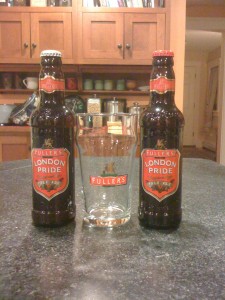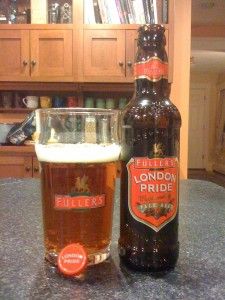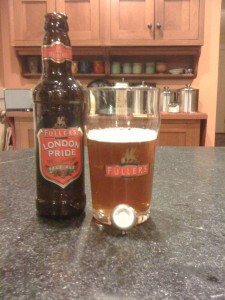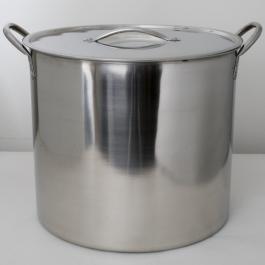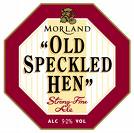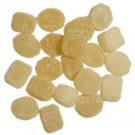Recipe Update – Fullers London Pride clone (9/10)
 Well they say good things come to those who wait and so it has come to pass with this the final clone of the English Pale series, the Fuller London Pride, started at the end of January of 2010 and opened yesterday to much fanfare. This clone really does have a high standard to reach. Not only is it a very tasty and popular commercial brew but it is also one that is relatively easy to come by in the USA. So in order to really put this clone to the test I went out and acquired a bottle of the real stuff in order to perform a side by side taste test. The results were revealing.
Well they say good things come to those who wait and so it has come to pass with this the final clone of the English Pale series, the Fuller London Pride, started at the end of January of 2010 and opened yesterday to much fanfare. This clone really does have a high standard to reach. Not only is it a very tasty and popular commercial brew but it is also one that is relatively easy to come by in the USA. So in order to really put this clone to the test I went out and acquired a bottle of the real stuff in order to perform a side by side taste test. The results were revealing.
First the colour and head. I have included pictures as evidence, taken at the same time in the same light on the same camera to ensure accuracy. As the picture demonstrate the brew color is on the money though not as bright due to lack of filtration. The head is slightly off but the clone is bottle conditioned and the commercial bottle is force carbonated. The mouthfeel is identical which I can attribute to the Burtonization of the water.
So what about the taste, something a little difficult to demonstrate on a blog or with a camera. It is close, which is why I gave the brew a 9/10. As a reminder the The Real Ale Almanac described the beer as an:
Astonishingly complex beer for its gravity, a marvelous melange of malt, hops and fruit.
and the Brew Your Own British Real Ale” as a:
…fine for drinking on its own or with full flavoured food. A multi-layered delight of malt and hops and a deep intense finish with hop and ripening fruit notes.
The taste definitely lives up to the billing. This beer has a very simple malt bill and its the balance of hops that makes the beer dance on your tongue and it is the hops that I am going to alter to make this ale a 10. I have been using the Tinseth formula up till now and the one small issue I have with all my English Pale clones has been the strong hop character of the ale. This is partly a benefit of homebrew as the ales are fresh, bottle conditioned, unfiltered and unpasteurized, so who really knows what a commercial pint of Fuller Pride sampled directly out of the barrel really tastes like. But I am going to experiment using the Rager formula, which promotes less hops per IBU and I have made the necessary adjustments for the London Pride clone promoted to the permanent English Pales recipe page.
The ale was easy to brew. The White Labs Fullers yeast (#WLP002, Attenuation 63-70%, Flocculation: Very High) worked as advertised, the ale was in the secondary for a week and in the bottle for 4 weeks. I cannot express how happy this ale makes me, and not just the alcohol, its a true taste of South West London, my home and a place of many memories from rowing past the Fullers brewery to drinking in many a Fullers Pub.
So please enjoy and try your own version. This wraps up the English Pale series. The next time we brew the Pales it will be to perfect some of the recipes that fell short the first time around. Its been an experience, I have definitely got more comfortable with the ingredients and this probably attributes to why the ratings have improved from one recipe to the next. Here is the final breakdown:
- My example generic best bitter modelled after the BJCP style using only kent hops, Kentish Best Ale, was a solid 7/10
- After many upgrades my Fullers ESB also made it to a 7/10 after my lessons learned on aging ales
- Green King Abbot Ale – 6/10
- Wadworth 6X – 4/10
- Flowers Original Ale – 9/10
- Fuller London Pride – 9/10
This is truly a great line up of Ales with a magnificent history, so please brew a couple and pass along your feedback. None of these recipes made 10/10 so we have 1 point to make up. Next up will be the first review in the Old and Browns series, the Theakston Old Peculier, but given the aging requirements for this ale it won’t be for a while.
Happy St Paddy’s Day to one and all.
